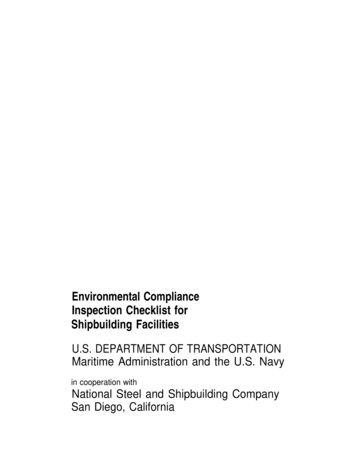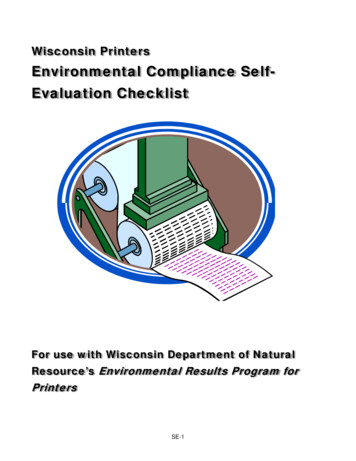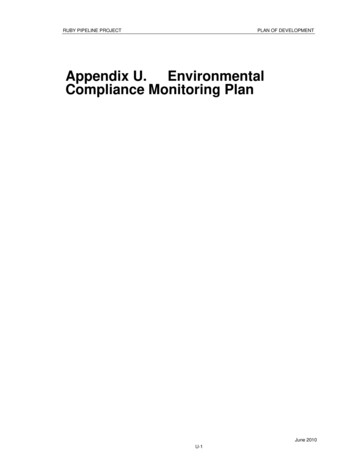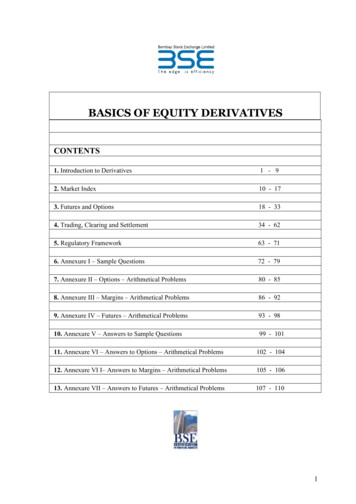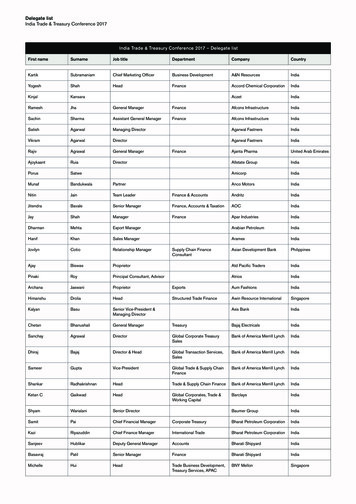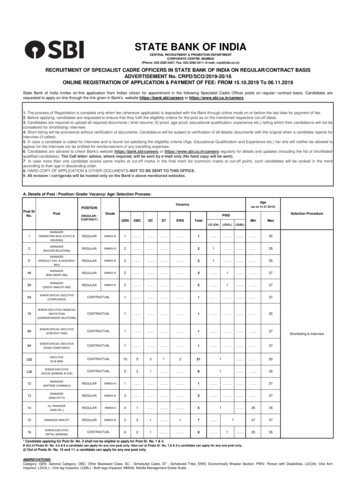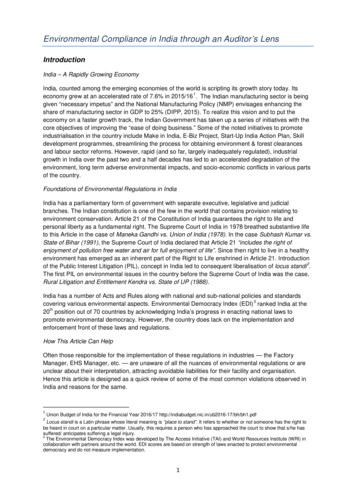
Transcription
Environmental Compliance in India through an Auditor’s LensIntroductionIndia – A Rapidly Growing EconomyIndia, counted among the emerging economies of the world is scripting its growth story today. Its1economy grew at an accelerated rate of 7.6% in 2015/16 . The Indian manufacturing sector is beinggiven “necessary impetus” and the National Manufacturing Policy (NMP) envisages enhancing theshare of manufacturing sector in GDP to 25% (DIPP, 2015). To realize this vision and to put theeconomy on a faster growth track, the Indian Government has taken up a series of initiatives with thecore objectives of improving the “ease of doing business.” Some of the noted initiatives to promoteindustrialisation in the country include Make in India, E-Biz Project, Start-Up India Action Plan, Skilldevelopment programmes, streamlining the process for obtaining environment & forest clearancesand labour sector reforms. However, rapid (and so far, largely inadequately regulated), industrialgrowth in India over the past two and a half decades has led to an accelerated degradation of theenvironment, long term adverse environmental impacts, and socio-economic conflicts in various partsof the country.Foundations of Environmental Regulations in IndiaIndia has a parliamentary form of government with separate executive, legislative and judicialbranches. The Indian constitution is one of the few in the world that contains provision relating toenvironment conservation. Article 21 of the Constitution of India guarantees the right to life andpersonal liberty as a fundamental right. The Supreme Court of India in 1978 breathed substantive lifeto this Article in the case of Maneka Gandhi vs. Union of India (1978). In the case Subhash Kumar vs.State of Bihar (1991), the Supreme Court of India declared that Article 21 “includes the right ofenjoyment of pollution free water and air for full enjoyment of life”. Since then right to live in a healthyenvironment has emerged as an inherent part of the Right to Life enshrined in Article 21. Introductionof the Public Interest Litigation (PIL), concept in India led to consequent liberalisation of locus standi 2.The first PIL on environmental issues in the country before the Supreme Court of India was the case,Rural Litigation and Entitlement Kendra vs. State of UP (1988).India has a number of Acts and Rules along with national and sub-national policies and standards3covering various environmental aspects. Environmental Democracy Index (EDI) ranked India at theth20 position out of 70 countries by acknowledging India’s progress in enacting national laws topromote environmental democracy. However, the country does lack on the implementation andenforcement front of these laws and regulations.How This Article Can HelpOften those responsible for the implementation of these regulations in industries — the FactoryManager, EHS Manager, etc. — are unaware of all the nuances of environmental regulations or areunclear about their interpretation, attracting avoidable liabilities for their facility and organisation.Hence this article is designed as a quick review of some of the most common violations observed inIndia and reasons for the same.12Union Budget of India for the Financial Year 2016/17 s standi is a Latin phrase whose literal meaning is “place to stand”. It refers to whether or not someone has the right tobe heard in court on a particular matter. Usually, this requires a person who has approached the court to show that s/he hassuffered/ anticipates suffering a legal injury.3The Environmental Democracy Index was developed by The Access Initiative (TAI) and World Resources Institute (WRI) incollaboration with partners around the world. EDI scores are based on strength of laws enacted to protect environmentaldemocracy and do not measure implementation.1
It is to be noted that the status of compliance with environmental regulations and the drivers forachieving compliance vary widely between different industry sectors, scales of operations, and States.This article is based on the most common trends observed by the authors across various industrysectors and States in India. The views presented here do not represent the condition of any specificsector or group of industries; nor do they represent conditions in any particular State within India.Common Environmental Compliance Gaps Observed in India1. Lack of Valid Environmental Permits: Setting up an industry in India requires environmentalpermits among several other licenses, and some industrial facilities do not obtain theEnvironmental Clearance (EC), Consent to Establish (CTE), or Consent to Operate (CTO) permitsthat are required for operation. Other environmental permits including Hazardous WastesAuthorisation and Bio-medical Wastes Authorisation must also be obtained depending onoperations conducted at the facility. In other cases, industries that initially obtained these permitsdo not renew the same prior to the dates of expiration. Others do not obtain prior consent from theconcerned State Pollution Control Board (SPCB)/ Pollution Control Committee (PCC) beforemaking changes to installed equipment, processes, raw materials, or production (includingchanges to production capacity and product mix).2. Omission of Details of Site Operations in Applications, Statutory Records & Returns:Another common observation is omission of details of site operations from applications forenvironmental permits as well as from statutory records and returns [e.g. Water Cess Returns(Form-1), Annual Environmental Statement (Form-V), Annual Hazardous Waste Returns (Form-4),Annual Report under Bio-medical Waste Rules, 1998 (Form-II), Record of Hazardous Wastes(Form-3), Hazardous Waste Labels (Form-12), Hazardous Wastes Manifests (Form-13), Returnsunder Batteries Rules, 2001 (Form-I), and Records under E-Waste Rules, 2011 (Form-2)].Some common details often omitted from records and returns include: Details of water consumed for different applications are omitted in water cess returns; Emissions from stacks fire water pumps and vents of local exhaust systems are omitted inConsent applications and Form V; Cooling tower blow-down is omitted in Consent applications and Form V; Empty chemical containers and waste oil are omitted in application for Authorisation and inForm 3 and Form 4; Analysis results for soil and groundwater monitoring are omitted in Form 3; Hazardous waste categories are omitted in Form 12 and Form 13; and The date of generation of hazardous waste is omitted in Form 12.3. Lack of Proper Waste Management: One of the areas where compliance gaps are commonlyobserved across a spectrum of industries is in the area of waste management. The compliancegaps observed include: Inadequate segregation of wastes; Lack of documented records of waste characterisation and inventory; Lack of prescribed labels on containers of hazardous chemicals and hazardous wastes; Lack of appropriate storage areas (i.e., designated, segregated, weather-proof storage areaswith secondary containment, impervious floors, and appropriate caution boards for hazardouschemicals, fuels, and hazardous wastes); and Lack of documented information regarding the waste vendors and final fate of disposed wastes.4. Lack of Spill Response Plans and Equipment: A spill in a factory can cause significant loss tolife and property, especially in factories using and storing hazardous chemicals. While maintaining2
a spill response plan and associated equipment is not an explicitly stated regulatory requirementunder present Indian laws, this is necessary to comply with the General Duty clauses containedunder the Factories Act, 1948; the Manufacture, Storage & Import of Hazardous Chemicals Rules,1989 as amended 2000 (hereinafter “MSIHC Rules, 1989”); and the Hazardous Wastes(Management, Handling & Transboundary Movement) Rules 2008 (hereinafter “Hazardous WastesRules, 2008”). Due to the lack of explicit regulatory requirements, most factories are not aware ofthis, and spill response plans are often absent in Indian factories.5. Lack of Appropriate Training, Equipment, and Information to Workers and NeighbouringCommunities: It is commonly observed that workers engaged in handling, storage and use ofhazardous chemicals and hazardous wastes are not provided appropriate training, equipment, andinformation to ensure their safety and prevent risks to their health and well-being. While this puts atrisk life and property in the industry and beyond, it is also in violation of General Duty clausesunder the Factories Act, 1948, MSIHC Rules, 1989, and Hazardous Wastes Rules, 2008.6. Effluent Discharge without Treatment: Certain industries discharge effluents into theenvironment (such as through storm runoff; used fire water; cooling tower blow-down; floor anddrum washings) without adequate prior treatment. By allowing the discharge of polluting matterinto streams, drains, sewers, or on land, they potentially violate Section 7 of the Environment(Protection) Act, 1986 and Section 24 of the Water (Prevention and Control of Pollution) Act, 1974.Should it be proved that the untreated effluent contains polluting matter in excess of prescribedstandards, such industries could face stringent enforcement measures. Should such discharge beproven to be the cause of environmental degradation (on-site or off-site), liability to clean-up andrestore the environment to its original state may be required.Most Common Reasons for Regulatory Non-ComplianceSome of the most common reasons for non-compliance with environmental regulations are listedbelow.1. Lack of Management Commitment: Lack of visible management commitment is the mostcommon reason for industries not considering environmental aspects as an integral part of theiroperations and decision-making. Treating environmental management as an add-on or additionalexpense often leads to sub-optimal environmental performance including compliance gaps.2. Lack of Adequate Knowledge of the Applicable Regulations – India has numerous regulatoryand enforcement authorities (at times under different Ministries), covering various aspects of theenvironment. Apart from MoEF&CC, other Ministries such as Ministry of Petroleum & Natural Gasand Ministry of Water Resources also administer some laws that are related to environmentalaspects. Often, the factory management and personnel responsible for complying with theseregulations are not fully aware of applicable regulations and actions required by them. This leadsto compliance gaps.3. Lack of Understanding of Actions Required to Demonstrate Compliance – Being aware ofrelevant laws applicable to an industry is one thing, but having a clear understanding of the actionsthat need to be taken to demonstrate compliance is quite another.The Indian legal system belongs to the Common Law family and therefore, at times uses broadlanguage without specific and prescriptive requirements. This ambiguity makes it even tougher forindustry stakeholders to understand actions that may be required to demonstrate desiredcompliance. Common examples of this include ambiguity around: Regulatory requirements for secondary containment — most factories are unsure whetherprovision of secondary containment to liquid chemicals and oils is a regulatory requirement andif so, the volume of secondary containment required; Requirements to develop and maintain a spill response plan, which was mentioned earlier; Actions required to demonstrate due diligence in disposal of hazardous wastes generated; and3
Requirement for soil and groundwater surveillance and monitoring (for factories using orhandling hazardous chemicals and hazardous wastes).4. A Culture of ‘Casual Compliance’: An organisational culture of casual compliance that permitsnon-compliance in the interest of greater profits has proven to be dangerous. This culture of casualcompliance, when coupled with the management’s belief that the cost of compliance is much morethan that of merely ‘managing’ the regulators is one of the main causes of the observedcompliance gaps.5. Lack of Adequate Resources – Flowing from the culture of casual compliance is the issue of lackof adequate resources. For effective compliance with regulations financial and human resourcesare essential. A dearth of adequate resources to ensure compliance with regulations often occursin one of the following two ways: Resources not being allocated or being allocated in inadequate amounts; and Resources allocated not being fit for purpose. This is especially true for human resources andequipment provided to achieve compliance.6. Lack of adequate resources for regulators: For environmental compliance to be enforced, theregulators and enforcement agencies also need to have sufficient resources. A lack of these isoften observed among regulatory bodies such as SPCBs/ PCCs. The SPCBs and PCCs were firstconstituted under the Water Act, 1974 when India did not have any other environmental regulationand very few industrial units. While the number of environmental regulations and industrial unitshave both increased manifold since 1974, these agencies have not seen a proportionate increasein staff strength or budget allocations.ConclusionWhile there exist real challenges to achieving full compliance with environmental regulations, this isnot an insurmountable obstacle. Each of the common compliance gaps noted above, as well as themost common reasons for their existence, can be resolved with visible management commitment andsustained effort towards achieving compliance.Management commitment when combined with an efficient, management systems-driven approachtowards compliance has been proven to yield rich results. Key elements of such a system usuallyinclude: comprehensive regulatory registers, tracking of all required actions, periodic internal andexternal compliance assessments, an appreciation of root causes of non-compliance rather than
For effective compliance with regulations financial and human resources are essential. A dearth of adequate resources to ensure compliance with regulations often occurs in one of the following two ways: Resources not being allocated or being allocated ininadequate amounts; and Resources allocated not being fit for purpose. This is especially true for human resources and equipment .
